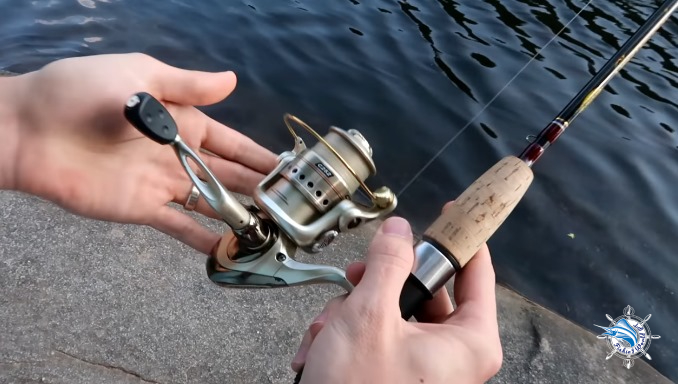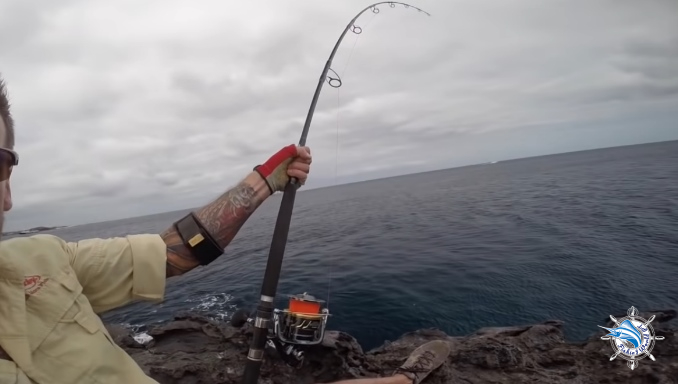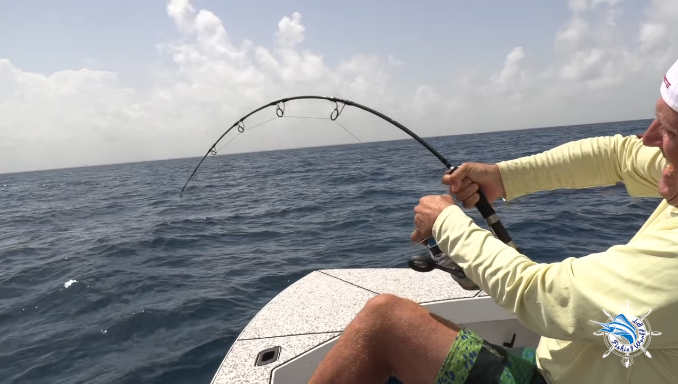How to Reel in a Fish?
How to reel in a fish? To do this, you must understand how the fish you are fishing with reacts when you are hooked. Each species of fish reacts differently. This might make a long run, swimming around obstacles. Or swimming back against the line.
To become a professional angler, reeling in a fish is just as important as how you cast your bait. Once you successfully set the hook, the fishes instinctively struggle to get free.
In this article, I will show you how to reel in a fish can be in the most accurate way. Let’s get started!
How do you know when to reel in a fish?
When you feel the line go taut, it’s time to start your exhilarating journey with the fish! Securely attach them and reel them in for an exciting experience.
As an angler, being prepared for the strike and knowing when to set the hook are key components of success. Knowing when to wait, and how long until you set it is an invaluable skill that comes with dedication and practice. However, many fishermen make a mistake in setting their hooks much too soon–it is one of the most frequent errors that occur on any given cast. To avoid missing out on potential catches, it’s essential to stay focused with each throw and be ready for any bites that may come your way. With proper discipline comes greater readiness; don’t let those strikes surprise you—set them confidently!
So, before learn how to reel in a fish, you should know when to set the hook exactly.
When to Set the Hook?
Topwater
With topwater lures, set the hook with perfect timing. When your line goes taut and you feel that telltale strike, hold off for just an extra second or two; this will give a fish enough time to take in the entire lure before you set the hook – resulting in more solid connections with each cast!
Moving Baits
Anglers tend to be too aggressive when setting the hook on moving baits, but this can lead to missed opportunities.
Anglers who use crankbaits, jerk baits, spinnerbaits, and other moving bait have to resist the urge for hard hooksets! Instead of jarringly yanking back with your rod, upon feeling a bite start reeling in while slowly pulling back on your rod. This will create an even pressure that allows you to drive the hook into its target.
Slow Bottom Contact Baits
To ensure a successful hookset with bottom contact baits, like jigs, texas rigs, and Carolina rigs, slow down your hookset. One should allow the fish to take 1-2ft of line before setting. This allows them time to get a good grip on your bait while allowing you to ready yourself for optimal positioning during the set – resulting in more confident strikes!
How to reel in a fish
Each species of fish reacts differently. This might make a long run, swimming around obstacles. Or swimming back against the line. When hooked, fishes in shallow water are more likely to jump and behave crazier than those hooked in deep water. Deep-water fishes often seek the bottom.
I’m going to talk about how reeling in and land all those fishes you’re going to be catching. Since bigger fishes pull harder, reeling in large fishes can be a fun challenge.
One of the first and most important things to learn is how to play a fish by not reeling in the line. In other words, reeling against the drag while the fish is pulling line and swimming away. When you notice that the fishes are no longer talking outline or are slowing down. That’s when it’s time to gain line by reeling.
Keep your fishing rod up at about a 45 degrees angle and maintain some pressure on the fish. Remember any time you give the fish slack or remove the pressure. The hook can become dislodged, and you’ve got a chance that you could lose that fish.
Without reeling the fish in, lift the rod’s tip and then reel as you lower the rod tip back down, keeping even pressure on the fishes. When you get the fish up to the boat, leave about a rod’s length of a line. This will reduce the chance of the hook coming out of the fish’s mouth while you’re landing it.

How to reel in a big fish
Reel in a big fish is a little different. So first, once you have the hook set that happens, we need to use proper techniques to avoid wrapping our tip to avoid losing the fish and not letting them come off the hook. And the key to that is keeping tension between your reel and that fishes at all times. This means the rod is bent as long as you’re not pointing it rod directly at the fish. The bend and the rod make sure I have pressure on that hook which keeps it from dislodging.
My technique is you pull up reel as we go down. We don’t need to get straight up. Once you get about 3/4 45 degrees angle, that’s fine. If you have a really big fish, you can fight them down. Whichever way the fish goes, you should be pulling in the opposite direction otherwise.
The line goes out so tight. It’s a heck of a lot of work that we don’t need for the reel and us. We want to use the rod to fight and not the reel to fight the fish.
Remember, we’re fighting a bigger fish always keep a bend in that rod. You never let it wrap around your tip. Use the rod to fight the fishes and not the reel.

Tips For Reeling in Big Fish
Keep The Line Tight, But Not Too Tight
Fishing is a game of precision and patience. It’s all about maintaining a measured tension on the line. Too much and you could snap it; too little tension will give the fish an easier way out – bringing disappointment instead of success! Steady though: pull with control from above, keeping the tip up for better leverage as you reel in smoothly; fishing success awaits those who heed this advice!
Let The Fish Run
Instead of fighting against a fish’s determined run for freedom, allow the line and drag to do their job by giving some slack. Adjust the drag and let them tire themselves out while they take out the line gradually. By allowing this process you increase your chances of successfully reining in that trophy fish! This will help tire out your catch over time so you can reel it in with ease – making every fishing outing as successful as possible!
Pull Up, Reel On The Down Motion, And Repeat
The key to successful fishing lies in a dynamic rhythm: pull up, the reel on down. To ensure your catch won’t escape you quickly, lift the rod tip with confidence and purpose and bring that big fish closer as you lower it again – all while maintaining an intentional pace when reeling in line. With this technique, fishermen can masterfully overcome resistance from even the most challenging catches!
Keep Them Out Of Structures
For inshore anglers, keep your eyes peeled: when a fish heads towards cover, it is crucial to act quickly and decisively. If they make their way into logs, rocks, or reefs the line can be strained leading to breakage – there’s no time for hesitation! If your prized fish heads towards cover then you’ll need all hands (or fins) – quickly draw that line tight and crank them away from obstacles as hard as you can. As unfortunate as it may seem; in this instance prevention certainly beats cure so do whatever possible to keep them out of those structures before they make a break for safety – lest ye lose thy trophy forever more!
Questions & Answers
Which direction do you reel in a fish?
With a conventional reel, it should be facing up. The crank should be going forward. You have to make sure that the non-reeling hand above the reel helps give you torque to fight bigger fishes. Never crank the reel backward.
Which hand should you reel with?
Just like spinning, if you are right-handed use one that has the crank handle on the left side. Now you casting and holding the rod in the right hand. Left-handed anglers should choose one with the crank handle on the right side. Now you casting and holding the rod in the left hand.
What is the difference between reeling in a fish and just pulling it in?
Reeling in a fish requires more finesse and patience than just pulling it in. Reeling in a fish requires the angler to use their reel to pull the line in while pulling it in simply requires pulling the rod tip towards you without using your reel. Reeling in is typically used for larger or more powerful fish as it gives you greater control and helps ensure they don’t escape. Pulling a fish usually works best when fishing for smaller breeds of fish.
Why is it important to keep the rod tip up when reeling in?
Keeping the rod tip up ensures that tension is kept on the line throughout retrieving – allowing anglers to get their catch closer and overcome any resistance from a fighting fish! Additionally, maintaining an upward angle will help reduce fatigue by taking some of the strain off your arms and shoulders. Proper posture and technique are essential to achieving a successful catch, so be sure to keep your rod tip up when reeling in that trophy!
How can I avoid tangling my line when reeling in a fish?
Tangling your line can be a common issue when reeling in fish, but there are some steps you can take to reduce the risk! First, make sure all of your guides (the eyes on your rod) are clean and free from debris. Additionally, checking your knots before each cast is recommended as they provide greater integrity while fighting a fish.
Finally, keep constant tension on the line by engaging the reel and slowly pulling it in – this will help maintain a tight angle between you and the fish so that it doesn’t wrap around anything in the water or off-shore objects. If the line starts to coil up or become tangled, slow down and make any necessary adjustments with your reel before continuing. Additionally, take care to never let go of the line – you must maintain a good grip so you can adjust if needed. You should also ensure that your drag is set properly according to what type of fish you are targeting. A properly tensioned line will help prevent wind knots and other fishing-related tangles!
What should I do if my fish is too big to reel in?
If you find yourself in this situation it’s important to take your time and remain patient. First, try using a net if the fish is close enough for you to reach. If this isn’t possible then use the weight of your rod to slowly tire out the fish and bring it closer. You may also want to consider bringing along a gaff or landing net as they can provide extra support while reeling in larger catches. Finally, try pumping your rod tip up and down and moving side-to-side – this will give the fish less tension on its line, allowing you to more easily regulate its movements!
Conclusion
After a strike occurs, the hook is set, the fish is hauled in, and the caught fish is removed. With the right bait, technique, and patience fishing can be a rewarding experience. Whether you have been fishing your entire life or it is your first time trying it out, you can catch some fantastic fish with practice and knowledge. Have fun and keep practicing! Good luck!
Above is the entire article on “How to reel in a fish?” What do you think? These tips should help you successfully reel in more catches, making your days on the water even more fun.
Remember, everything depends on your personal preferences. Any reels are expensive or cheap, it will still be useless if you can’t master them.
I hope this article is helpful to you. Do you have another idea?
Further reading:
- Other info about fishing in Fishingandhuntingsports
- Fishing reel Wikipedia
- What Is A Big Pit Reel?

